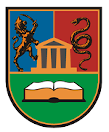Please use this identifier to cite or link to this item:
https://scidar.kg.ac.rs/handle/123456789/21046Full metadata record
| DC Field | Value | Language |
|---|---|---|
| dc.contributor.author | Ribac, Milojka | - |
| dc.date.accessioned | 2024-07-29T11:21:42Z | - |
| dc.date.available | 2024-07-29T11:21:42Z | - |
| dc.date.issued | 2024 | - |
| dc.identifier.issn | 1451673X | en_US |
| dc.identifier.uri | https://scidar.kg.ac.rs/handle/123456789/21046 | - |
| dc.description | Istraživanje sprovedeno u radu finansiralo je Ministarstvo prosvete, nauke i tehnološkog razvoja Republike Srbije (Ugovor o realizaciji i finansiranju naučnoistraživačkog rada NIO u 2022. godini broj 451-03-68/2022-14/200198). | en_US |
| dc.description.abstract | The paper examines models of reported speech in Vesna Kapor’s novel Nebo, tako duboko from the point of view of syntax and stylistics. According to the classification by Miloš Kovačević, the following types of reported speech were identified in the novel: 1) direct speech (basic model), 2) direct speech without dialogue tags, 3) free indirect speech, 4) free indirect speech accompanied with narrator’s voice, 5) free indirect speech introduced with verba dicendi and free indirect speech representing character’s voices that are not spoken aloud, 6) direct speech which contains fragments of character’s words, 7) direct speech containing deictic expressions instead of character’s exact words, 8) monologic direct speech, 9) indirect speech (basic model), 10) indirect speech without subordinate conjunctions, 11) expressive indirect speech, which maintains interrogative form and question marks, and 12) semi-direct speech. The dominant model used in the novel is the free indirect speech introduced with quotation marks or introductory expressions, which is in accordance with the specific graphostylemic features of the text. Quotation marks appear almost as an exception, and italics have a very specific role in demarcation of the text segments. The author’s choice is extremely stylogenic and justified, since it achieves a shift of the reader’s focus from a literal factual sequence of events to an emotional engagement and a kind of participation in reviving the memory of Tara. The echoes of the past, the time she was still alive, are expressed with short and concise cuts of memory. Reviving the memory of Tara makes her alive in a way. | en_US |
| dc.language.iso | sr | en_US |
| dc.publisher | Faculty of Education in Jagodina, University of Kragujevac | en_US |
| dc.relation.ispartof | Uzdanica: časopis za jezik, književnost i pedagoške nauke | en_US |
| dc.rights | CC0 1.0 Universal | * |
| dc.rights.uri | http://creativecommons.org/publicdomain/zero/1.0/ | * |
| dc.subject | reported speech | en_US |
| dc.subject | direct speech | en_US |
| dc.subject | indirect speech | en_US |
| dc.subject | modifications of basic reported speech models | en_US |
| dc.subject | Vesna Kapor | en_US |
| dc.subject | lament | en_US |
| dc.title | O TIPOVIMA GOVORA U ROMANU NEBO, TAKO DUBOKO VESNE KAPOR | en_US |
| dc.title.alternative | ON TYPES OF SPEECH IN THE NOVEL NEBO, TAKO DUBOKO BY VESNA KAPOR | en_US |
| dc.type | article | en_US |
| dc.description.version | Published | en_US |
| dc.identifier.doi | 10.46793/Uzdanica21.1.127R | en_US |
| dc.type.version | PublishedVersion | en_US |
| Appears in Collections: | The Faculty of Philology and Arts, Kragujevac (FILUM) | |
Files in This Item:
| File | Description | Size | Format | |
|---|---|---|---|---|
| 13 - Милојка С. Рибаћ - О типовима говора у роману Небо, тако дубоко Весне.pdf | 593.03 kB | Adobe PDF |  View/Open |
This item is licensed under a Creative Commons License


